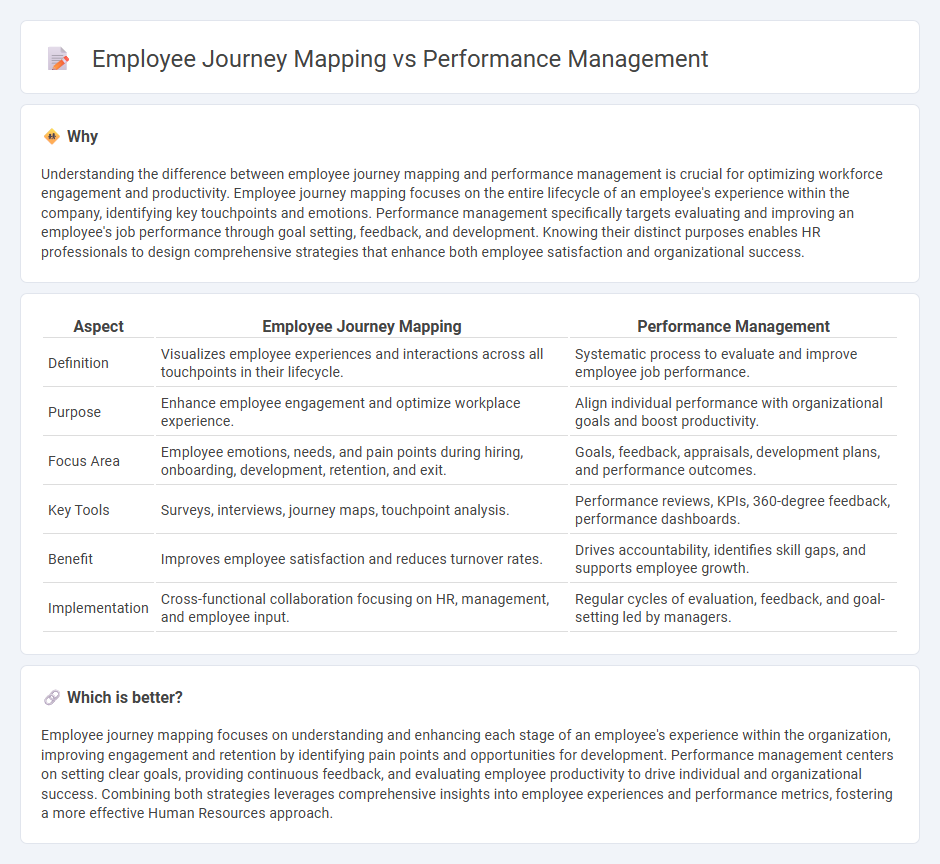
Employee journey mapping captures the complete employee experience from recruitment to exit, highlighting touchpoints that affect engagement and satisfaction. Performance management focuses on assessing and enhancing employee productivity through goal setting, feedback, and development plans. Explore deeper insights into how these strategies optimize workforce effectiveness and organizational growth.
Why it is important
Understanding the difference between employee journey mapping and performance management is crucial for optimizing workforce engagement and productivity. Employee journey mapping focuses on the entire lifecycle of an employee's experience within the company, identifying key touchpoints and emotions. Performance management specifically targets evaluating and improving an employee's job performance through goal setting, feedback, and development. Knowing their distinct purposes enables HR professionals to design comprehensive strategies that enhance both employee satisfaction and organizational success.
Comparison Table
| Aspect | Employee Journey Mapping | Performance Management |
|---|---|---|
| Definition | Visualizes employee experiences and interactions across all touchpoints in their lifecycle. | Systematic process to evaluate and improve employee job performance. |
| Purpose | Enhance employee engagement and optimize workplace experience. | Align individual performance with organizational goals and boost productivity. |
| Focus Area | Employee emotions, needs, and pain points during hiring, onboarding, development, retention, and exit. | Goals, feedback, appraisals, development plans, and performance outcomes. |
| Key Tools | Surveys, interviews, journey maps, touchpoint analysis. | Performance reviews, KPIs, 360-degree feedback, performance dashboards. |
| Benefit | Improves employee satisfaction and reduces turnover rates. | Drives accountability, identifies skill gaps, and supports employee growth. |
| Implementation | Cross-functional collaboration focusing on HR, management, and employee input. | Regular cycles of evaluation, feedback, and goal-setting led by managers. |
Which is better?
Employee journey mapping focuses on understanding and enhancing each stage of an employee's experience within the organization, improving engagement and retention by identifying pain points and opportunities for development. Performance management centers on setting clear goals, providing continuous feedback, and evaluating employee productivity to drive individual and organizational success. Combining both strategies leverages comprehensive insights into employee experiences and performance metrics, fostering a more effective Human Resources approach.
Connection
Employee journey mapping identifies key touchpoints in an employee's lifecycle, enabling HR to tailor performance management strategies effectively. By analyzing experiences such as onboarding, training, and feedback, organizations can align performance goals with employee development needs. This connection enhances engagement, productivity, and retention through targeted interventions at critical stages.
Key Terms
**Performance Management:**
Performance management involves setting clear goals, continuous feedback, and performance evaluations to enhance employee productivity and align individual objectives with organizational strategy. This process leverages data-driven insights and regular check-ins to identify strengths and areas for improvement, fostering professional growth and accountability. Explore how integrating advanced performance management techniques can transform workforce efficiency and engagement.
Key Performance Indicators (KPIs)
Performance management centers on measuring and improving employee output through Key Performance Indicators (KPIs) such as productivity, efficiency, and goal attainment metrics. Employee journey mapping examines the entire experience of an employee within an organization, highlighting touchpoints that affect engagement and satisfaction, but it integrates KPIs related to retention rates, employee satisfaction scores, and onboarding effectiveness to optimize workforce performance. Explore how aligning KPIs in both approaches can enhance overall organizational success.
360-Degree Feedback
Performance management involves continuous evaluation and development of employee skills aligned with company goals, while employee journey mapping visualizes the entire employee experience from onboarding to exit. Integrating 360-degree feedback within performance management enhances comprehensive assessments by collecting input from peers, supervisors, and subordinates, leading to more accurate and actionable insights. Discover how leveraging 360-degree feedback in both strategies can transform talent development and engagement.
Source and External Links
What Is Performance Management? The Complete Guide - This guide provides an overview of performance management, including methods like goal setting and continuous performance management to enhance employee development and organizational performance.
What is Employee Performance Management? - This article discusses the role of technology in performance management, emphasizing the importance of aligning employee goals with business objectives and using software to support this process.
Performance Management - KU's Human Resources - This resource outlines performance management as an ongoing process involving goal setting, feedback sessions, and development planning to optimize individual and organizational performance.
 dowidth.com
dowidth.com